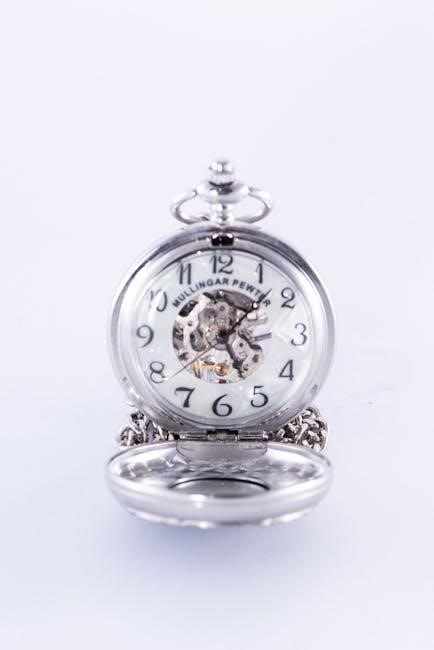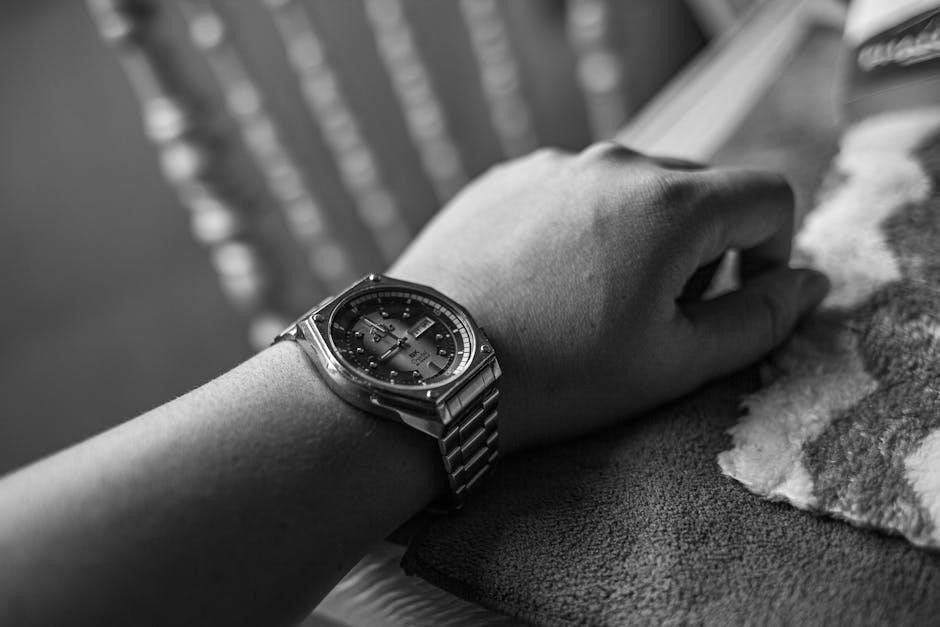A manual winding watch requires the wearer to hand-wind the crown daily, storing energy in the mainspring, unlike automatic watches, which wind through movement, ensuring precise timekeeping.
Definition of a Manual Winding Watch
A manual winding watch is a timepiece that requires the wearer to hand-wind the crown daily to store energy in the mainspring. This mechanical process powers the watch’s movement, ensuring accurate timekeeping. Unlike automatic watches, which wind through wrist motion, manual winding watches demand intentional daily interaction, emphasizing traditional craftsmanship and horology.
Why Manual Winding Watches Remain Relevant Today
Manual winding watches remain relevant due to their timeless appeal, craftsmanship, and emotional connection. They offer a tangible link to horological history, appealing to collectors and enthusiasts. The daily ritual of winding fosters a personal bond with the timepiece, emphasizing mindfulness and tradition. Additionally, their mechanical simplicity often results in lower maintenance compared to automatic watches, making them a preferred choice for connoisseurs seeking both functionality and artistic value in the modern era.

History of Manual Winding Watches
Manual winding watches emerged in the late 19th century, evolving from pocket watches into wristwatches by the early 20th century, with Peter Henlein pioneering early mechanisms.
Origins and Evolution of Manual Winding Mechanisms
Manual winding mechanisms trace back to the 15th century with Peter Henlein’s pocket watches. By the 19th century, they evolved into wristwatches, popularized during World War I. The crown-based system emerged, allowing users to wind watches by turning the crown clockwise, storing energy in the mainspring. Over time, these mechanisms became more refined, improving accuracy and reliability, while maintaining the traditional appeal of manual winding.
The Resurgence of Manual Winding Watches in Modern Times
Manual winding watches have seen a revival in modern times, cherished for their craftsmanship and exclusivity. Collectors and enthusiasts appreciate the tactile experience of winding, fostering a deeper connection to timekeeping. Modern brands blend traditional mechanics with contemporary design, appealing to both vintage purists and younger collectors. The resurgence reflects a desire for authenticity and sustainability, as these watches often avoid battery replacements, making them a timeless choice in an era dominated by digital technology and fast-paced innovation.
How Manual Winding Watches Work
Manual winding watches are powered by winding the crown, which stores energy in the mainspring, eliminating the need for batteries and ensuring precise mechanical functionality.
Mechanical Movement and Energy Storage
A manual winding watch operates through a mechanical movement, where energy is stored in a mainspring where winding the crown tightens it. This stored energy powers the watch.
The Role of the Crown in Winding
The crown is a crucial component in manual winding watches. It is used to wind the mainspring by turning it clockwise, which stores energy to power the watch. The crown must be wound daily to maintain the watch’s functionality. Proper winding involves turning the crown until resistance is felt, indicating the mainspring is fully wound. Over-winding can damage the mechanism, so care must be taken to stop when resistance is felt. The crown also serves to set the time and date, typically by pulling it out to adjust. Regular and gentle winding ensures consistent timekeeping and prolongs the watch’s lifespan.

Manual Winding vs. Automatic Winding Watches
Manual winding watches require turning the crown to store energy, while automatic watches wind through wrist motion, eliminating the need for daily manual winding.
Key Differences in Functionality
Manual winding watches require the wearer to turn the crown daily to store energy, while automatic watches wind through wrist motion, eliminating manual intervention. Unlike automatic watches, manual winding watches lack a rotor, relying solely on user interaction. Automatic watches are more convenient for everyday wear, as they maintain power reserve through movement, whereas manual watches need consistent winding to function. This fundamental difference in energy sourcing separates the two mechanisms in terms of maintenance and operation.
Pros and Cons of Manual Winding Watches
Manual winding watches offer a unique, tactile experience and often feature intricate mechanical craftsmanship. They are lighter and thinner due to the absence of a rotor, appealing to purists. However, they require daily winding, which can be inconvenient for some users. Over-winding risks damaging the mechanism, and they typically have shorter power reserves compared to automatic watches. Despite these drawbacks, many enthusiasts appreciate their historical significance and the direct connection to horological tradition they provide.
Advantages of Manual Winding Watches
Manual winding watches are lighter, slimmer, and often more affordable. They connect users to horological tradition, offering a personal, tactile experience that appeals to watch enthusiasts and collectors.
Unique Appeal for Watch Collectors
Manual winding watches captivate collectors with their mechanical simplicity and historical significance. They often feature intricate craftsmanship, making each piece a testament to horological artistry. The tactile experience of winding fosters a deeper connection to timekeeping traditions. Collectors value these timepieces for their elegance, precision, and the stories they carry, often seeking rare or vintage models. This blend of functionality and heritage makes manual winding watches highly desirable in horology circles.
Lower Maintenance Compared to Automatic Watches
Manual winding watches often require less maintenance than automatic watches due to their simpler mechanics. Without the complex rotor system, they have fewer moving parts, reducing the risk of wear and tear. Additionally, manual watches are less prone to over-winding issues, as the winding process is entirely under the wearer’s control. This makes them a practical choice for those seeking a reliable timepiece with minimal servicing needs, combining elegance with functional simplicity.
Disadvantages of Manual Winding Watches
Manual winding watches require daily winding, which can be inconvenient. Over-winding risks damaging the mechanism, and forgetting to wind the watch can stop its timekeeping function entirely.
Daily Winding Requirement
A manual winding watch demands consistent attention, as it must be wound daily to maintain accurate timekeeping. Forgetting to wind it can cause the watch to stop. Many owners develop a morning routine, winding their watch as part of dressing. This daily task ensures the mainspring remains tensioned, providing a reliable power reserve. While some may find this process meditative, others view it as a hassle. Regular winding is essential to keep the watch functioning optimally and avoid interruptions in timekeeping performance.
Higher Risk of Over-Winding
Manual winding watches carry a higher risk of over-winding, which can damage the mainspring or gear train. As the crown is turned, resistance indicates the mainspring is fully tensioned. Ignoring this sign can lead to mechanical stress. Over-winding is a common mistake, especially for inexperienced users, and may require costly repairs. It’s crucial to wind carefully and stop when resistance is felt to preserve the watch’s longevity and functionality, ensuring it remains accurate and reliable over time.
Popular Brands Known for Manual Winding Watches
Brands like Audemars Piguet, Vacheron Constantin, and Blancpain are renowned for their manual winding watches, offering intricate craftsmanship and timeless elegance, appealing to purists and collectors alike.
Historical Brands with a Legacy in Manual Winding
Brands like Patek Philippe, Rolex, and Breguet have shaped the legacy of manual winding watches. Founded in 1839, Patek Philippe is celebrated for its intricate mechanical movements. Rolex, with its iconic Daytona models, blends racing heritage with precision engineering. Breguet, established in 1775, is renowned for its Reine de Naples collection. These brands have contributed significantly to horological history, offering masterpieces that embody craftsmanship, elegance, and timeless appeal for watch enthusiasts and collectors worldwide.
Modern Brands Embracing Manual Winding Mechanics
Contemporary brands like A. Lange & Söhne and Jaeger-LeCoultre continue to innovate manual winding watches. Lange’s Saxonia series exemplifies minimalist design, while Jaeger-LeCoultre’s Master collection highlights precision engineering. These brands blend tradition with modern aesthetics, appealing to discerning collectors. Their commitment to craftsmanship ensures the enduring relevance of manual winding timepieces in today’s market, offering both functional excellence and artistic beauty. This approach keeps the essence of horology alive, attracting connoisseurs who value mechanical artistry and heritage.

How to Properly Wind a Manual Winding Watch
Pull out the crown, turn it clockwise until resistance is felt, indicating the mainspring is fully wound, then push the crown back to secure the timepiece.
Step-by-Step Winding Techniques
Grasp the watch face up, pull the crown out, and wind it clockwise until resistance is felt. Avoid over-winding. Push the crown back in to secure the timepiece.
Best Practices for Consistent Timekeeping
Establish a daily routine, winding your watch in the morning to ensure consistent power reserve. Wind clockwise until resistance is felt, but avoid over-winding. Store the watch in a cool, dry place when not worn. Regular maintenance by a professional is recommended to maintain accuracy. By following these practices, you ensure precise timekeeping and extend the lifespan of your manual winding watch, connecting you to the timeless tradition of horology.

Cultural and Aesthetic Significance
Manual winding watches embody tradition and craftsmanship, appealing to collectors who value mechanical artistry. Their timeless elegance and the ritual of winding create a personal, emotional connection.
Manual Winding Watches as a Symbol of Tradition
Manual winding watches are cherished as symbols of tradition, representing the origins of watchmaking. Their mechanical movements, passed down through generations, embody the artistry and craftsmanship of horology. Collectors and enthusiasts value these timepieces for their historical significance and the tactile experience of winding, which fosters a deeper connection to timekeeping. The resurgence of manual winding watches in modern times highlights their enduring appeal, blending nostalgia with the appreciation of timeless engineering.
The Artisanal Appeal of Manual Winding Timepieces
Manual winding watches captivate enthusiasts with their artisanal charm, blending intricate craftsmanship and timeless design. Each piece is a testament to the skill of master watchmakers, who meticulously assemble and decorate the movement by hand. The visible mechanical workings, often showcased through transparent casebacks, highlight the beauty of traditional horology. The tactile experience of winding and the precision of the movement create a deep emotional connection, making these timepieces sought after by collectors and connoisseurs who appreciate the artistry behind them.
Manual winding watches embody timeless craftsmanship, offering a unique connection to horological tradition. Their allure lies in their mechanical beauty and the satisfaction of winding, cherished by enthusiasts worldwide.
Final Thoughts on Manual Winding Watches
Manual winding watches are timeless pieces that combine horological craftsmanship with a tactile connection to timekeeping. Their mechanical beauty and the ritual of winding create a unique bond with the wearer. While modern technology offers convenience, the charm of manual winding lies in its simplicity and tradition. For collectors and enthusiasts, these watches represent a lasting appreciation for precision engineering and the art of watchmaking. They remain a celebrated choice for those who value heritage and the joy of mechanical timepieces.
The Future of Manual Winding in the Digital Age
Despite the rise of smartwatches and digital timekeeping, manual winding watches are poised to endure as symbols of tradition and craftsmanship. Their appeal lies in the blend of mechanical artistry and personal connection, which digital devices cannot replicate. Collectors and connoisseurs continue to cherish these timepieces, ensuring a niche yet vibrant market. As technology evolves, the appreciation for manual winding watches remains steadfast, preserving their legacy as tangible pieces of horological history in a rapidly changing world.